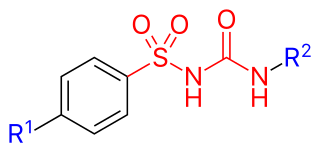Related Research Articles

Metformin, sold under the brand name Glucophage, among others, is the main first-line medication for the treatment of type 2 diabetes, particularly in people who are overweight. It is also used in the treatment of polycystic ovary syndrome. It is sometimes used as an off-label adjunct to lessen the risk of metabolic syndrome in people who take antipsychotics. Metformin is not associated with weight gain and is taken by mouth.
Drugs used in diabetes treat diabetes mellitus by altering the glucose level in the blood. With the exception of insulin, most GLP receptor agonists, and pramlintide, all are administered orally and are thus also called oral hypoglycemic agents or oral antihyperglycemic agents. There are different classes of anti-diabetic drugs, and their selection depends on the nature of diabetes, age, and situation of the person, as well as other factors.

The thiazolidinediones, abbreviated as TZD, also known as glitazones after the prototypical drug ciglitazone, are a class of heterocyclic compounds consisting of a five-membered C3NS ring. The term usually refers to a family of drugs used in the treatment of diabetes mellitus type 2 that were introduced in the late 1990s.

Pioglitazone, sold under the brand name Actos among others, is an anti-diabetic medication used to treat type 2 diabetes. It may be used with metformin, a sulfonylurea, or insulin. Use is recommended together with exercise and diet. It is not recommended in type 1 diabetes. It is taken by mouth.

Sulfonylureas or sulphonylureas are a class of organic compounds used in medicine and agriculture. The functional group consists of a sulfonyl group (-S(=O)2) with its sulphur atom bonded to a nitrogen atom of a ureylene group (N,N-dehydrourea, a dehydrogenated derivative of urea). The side chains R1 and R2 distinguish various sulfonylureas.
Antisense therapy is a form of treatment that uses antisense oligonucleotides (ASOs) to target messenger RNA (mRNA). ASOs are capable of altering mRNA expression through a variety of mechanisms, including ribonuclease H mediated decay of the pre-mRNA, direct steric blockage, and exon content modulation through splicing site binding on pre-mRNA. Several ASOs have been approved in the United States, the European Union, and elsewhere.

Pramlintide is an injectable amylin analogue drug for diabetes, developed by Amylin Pharmaceuticals. Pramlintide is sold as an acetate salt.

Gliquidone is an anti-diabetic medication in the sulfonylurea class. It is classified as a second-generation sulfonylurea. It is used in the treatment of diabetes mellitus type 2. It is marketed by the pharmaceutical company Boehringer Ingelheim (Germany).

Voglibose is an alpha-glucosidase inhibitor used for lowering postprandial blood glucose levels in people with diabetes mellitus. Voglibose delays the absorption of glucose thereby reducing the risk of macrovascular complications. Voglibose is a research product of Takeda Pharmaceutical Company, Japan's largest pharmaceutical company. Vogilbose was discovered in 1981, and was first launched in Japan in 1994, under the trade name BASEN, to improve postprandial hyperglycemia in diabetes mellitus.

Remogliflozin etabonate (INN/USAN) is a drug of the gliflozin class for the treatment of non-alcoholic steatohepatitis ("NASH") and type 2 diabetes. Remogliflozin was discovered by the Japanese company Kissei Pharmaceutical and is currently being developed by BHV Pharma, a wholly owned subsidiary of North Carolina, US-based Avolynt, and Glenmark Pharmaceuticals through a collaboration with BHV. In 2002, GlaxoSmithKline (GSK) received a license to use it. From 2002 to 2009, GSK carried out a significant clinical development program for the treatment of type-2 diabetes mellitus in various nations across the world and obesity in the UK. Remogliflozin etabonate's pharmacokinetics, pharmacodynamics, and clinical dose regimens were characterized in 18 Phase I and 2 Phase II investigations. Due to financial concerns, GSK stopped working on remogliflozin and sergliflozin, two further SGLT2 inhibitors that were licensed to the company, in 2009. Remogliflozin was commercially launched first in India by Glenmark in May 2019.

Alicaforsen is an antisense oligonucleotide therapeutic that targets the messenger RNA for the production of human ICAM-1 receptor and is being developed for the treatment of acute disease flares in moderate to severe Inflammatory Bowel Disease (IBD).

Tofogliflozin is an experimental drug for the treatment of diabetes mellitus and is being developed by Chugai Pharma in collaboration with Kowa and Sanofi. It is an inhibitor of subtype 2 sodium-glucose transport protein (SGLT2), which is responsible for at least 90% of the glucose reabsorption in the kidney. As of September 2012, the drug is in Phase III clinical trials.
Gliflozins are a class of drugs in the treatment of type 2 diabetes (T2D). They act by inhibiting sodium/glucose cotransporter 2 (SGLT-2), and are therefore also called SGLT-2 inhibitors. The efficacy of the drug is dependent on renal excretion and prevents glucose from going into blood circulation by promoting glucosuria. The mechanism of action is insulin independent.
SGLT2 inhibitors, also called gliflozins or flozins, are a class of medications that modulate sodium-glucose transport proteins in the nephron, unlike SGLT1 inhibitors that perform a similar function in the intestinal mucosa. The foremost metabolic effect of this is to inhibit reabsorption of glucose in the kidney and therefore lower blood sugar. They act by inhibiting sodium-glucose transport protein 2 (SGLT2). SGLT2 inhibitors are used in the treatment of type 2 diabetes. Apart from blood sugar control, gliflozins have been shown to provide significant cardiovascular benefit in people with type 2 diabetes. Several medications of this class have been approved or are currently under development. In studies on canagliflozin, a member of this class, the medication was found to enhance blood sugar control as well as reduce body weight and systolic and diastolic blood pressure.

Trelagliptin is a pharmaceutical drug used for the treatment of type 2 diabetes.

Ipragliflozin is a pharmaceutical drug for treatment of type 2 diabetes. Ipragliflozin, jointly developed by Astellas Pharma and Kotobuki Pharmaceutical, was approved in Japan on January 17, 2014, and in Russia on May 22, 2019.

Ionis Pharmaceuticals, Inc. is a biotechnology company based in Carlsbad, California, that specializes in discovering and developing RNA-targeted therapeutics. The company has 3 commercially approved medicines: Spinraza (Nusinersen), Tegsedi (Inotersen), and Waylivra (Volanesorsen) and has 4 drugs in pivotal studies: tominersen for Huntington’s disease, tofersen for SOD1-ALS, AKCEA-APO(a)-LRx for cardiovascular disease, and AKCEA-TTR-LRx for all forms of TTR amyloidosis.
Volanesorsen, sold under the brand name Waylivra, is a triglyceride-reducing drug. It is a second-generation 2'-O-methoxyethyl (2'-MOE) chimeric antisense therapeutic oligonucleotide (ASO) that targets the messenger RNA for apolipoprotein C3 (apo-CIII).

Gosogliptin is a drug for the treatment of type II diabetes. It is in the class of dipeptidyl peptidase-4 (DPP-4) inhibitors. It was discovered and developed through Phase 1 and Phase 2 by Pfizer. The crystal structure of DPP-4 in complex with gosogliptin is available. Its metabolism, excretion and pharmacokinetics in rat, dog and human have been described. A cost efficient route has been published. Other studies including Phase 3 studies were conducted in Russia. It is approved for use in Russia.
References
- 1 2 3 4 "IONIS GCCRRx". AdisInsight. Springer Nature Switzerland AG.
- ↑ Chikara G, Sharma PK, Dwivedi P, Charan J, Ambwani S, Singh S (April 2018). "A Narrative Review of Potential Future Antidiabetic Drugs: Should We Expect More?". Indian Journal of Clinical Biochemistry. 33 (2): 121–131. doi:10.1007/s12291-017-0668-z. PMC 5891460 . PMID 29651202.